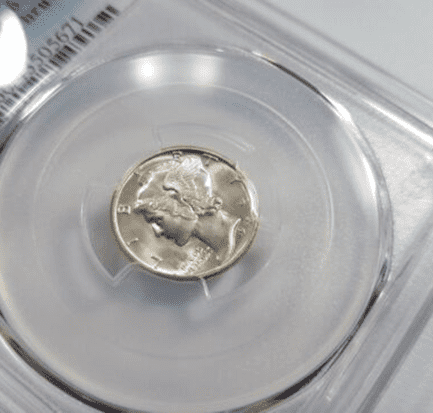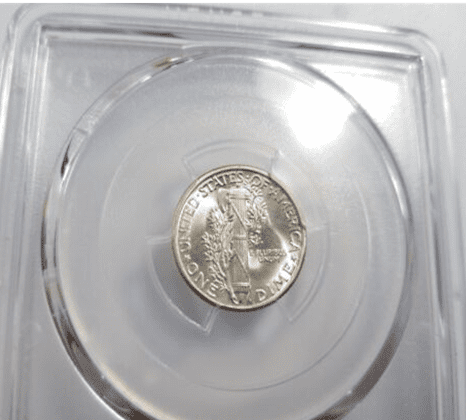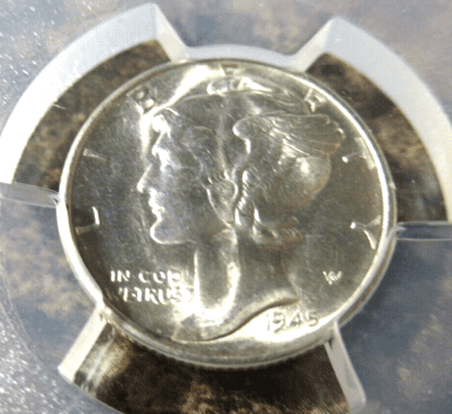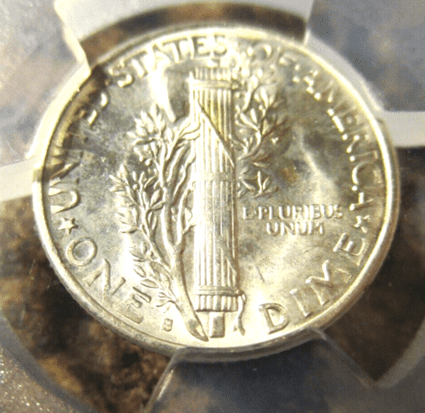What Is the 1945 Mercury Dime Made Of?
Many coin collectors consider the 1945 dime the most beautiful dime ever struck in the history of the United States. You can also say that it is one of the most attractive coins. It’s common to discover at least one Mercury Dime in the extensive collections of coin enthusiasts.
The 1945 Mercury Head Dime is quite common. What makes it unique is that it has full bands. Numerous 1945 dimes have received Mint State certification (around 7,000), but just a hundred or so have full bands. The 1945 dime with Full Bands is the ultimate condition-rarity for collectors seeking fully struck dimes.
If you are curious about the 1945 dime, you must continue reading this post. You’ll learn about the composition, design features, specs, weight, and historic milestones.
A noteworthy fact about the 1945 dime is that 90% of the coin was made of an alloy of silver, and the other 10% was copper. The coin weighs 2.5 grams and has a diameter of 17.91 millimeters. The edges are reeded with 118 reeds in total. The total number produced of all the coin varieties reached more than 240 million.
Adolph Weinman designed exquisite front and back designs for it in 1915. He gave the coin its distinctive appearance, and his design was used for decades. The Mercury Dime was initially known as the Winged Liberty Head Dime.
World War II ended in 1945, marking the end of the Mercury coin series production. Its production period lasted almost 30 years, which is considered a successful feat for any coin. The Mercury dime was then replaced by the Roosevelt dime design.
1945 Mercury Dime Varieties
The US Mint produced Mercury dimes in 1945. There were three official varieties issued at that time. Here’s a table that compares these varieties:
| Variety | Mint Center | Mintage |
| 1945-D Mercury Dime | Denver | 40,245,000 |
| 1945-P Mercury Dime | Philadelphia | 159,130,000 |
| 1945-S Mercury Dime | San Francisco | 41,920,000 |
| Total | 241,295,000 |
Aside from the official varieties, error coins were also produced in 1945. Read through the description of each variety mentioned below:
1945 D Mercury Dime
Edge: Reeded
Mint Mark: D
Place of minting: Denver
Year of minting: 1945
Face Value: $0.10 (ten cents)
Price: $2.22 to $4.70 (circulated condition)
Quantity produced: 13,938,000
Designer: Adolph Alexander Weinman
Composition: 90% Silver and 10% Copper
Mass: 2.5 grams
Diameter: 17.9 millimeters
Photo Source: USA Coin Book
All grades through MS67, including those classed as Full Bands specimens of the 1945-D Mercury dime, are common. The Denver minting has the least quantity produced compared to other varieties. 1945 D Mercury Dime has 40,245,000 mintages.
1945 P Mercury Dime
Edge: Reeded
Mint Mark: No mint mark
Place of minting: Philadelphia
Year of minting: 1945
Face Value: $0.10 (ten cents)
Price: $2.22 to $4.70 (Circulated condition)
Quantity produced: 159,130,000
Designer: Adolph Alexander Weinman
Composition: 90% Silver and 10% Copper
Mass: 2.5 grams
Diameter: 17.9 millimeters
Photo Source: PCGS
The 1945 Philadelphia dime is the fifth most produced Winged Liberty Head (Mercury) dime. The mintage of more than 159 million was the highest among all the minting in Denver and San Francisco during the 1945 dime production.
1945 S Mercury Dime
Edge: Reeded
Mint Mark: S
Place of minting: San Francisco
Year of minting: 1945
Face Value: $0.10 (ten cents)
Price: $2.22 to $4.70 (circulated condition)
Quantity produced: 41,920,000
Designer: Adolph Alexander Weinman
Composition: 90% Silver and 10% Copper
Mass: 2.5 grams
Diameter: 17.9 millimeters
Photo Source: USA Coin Book
The S mintmark on these coins is noticeably smaller than on conventional 1945-S Mercury dimes, making the 1945-S Micro S a popular last-year variant for the Mercury dime series.
In addition to the differences in size between the S mintmarks, the Micro S mintmark has considerably sharper-edged serifs than the standard 1945-S mintmark, which has more bulbous serifs. The San Francisco minting has the second-greatest number of coins among the three coin varieties.
List Of 1945 Mercury Dime Errors
As mentioned above, some dime coins were made with errors in 1945. These errors happened due to mechanical and human errors. Check out some examples of 1945 Mercury dime errors:
Planchet Error
 |
 |
Photo Source: eBay
Internal tensions or metal impurities bring on planchet flaws called lamination flaws. Discoloration, uneven surfaces, peeling, and splitting are all effects of lamination faults.
Lamination errors are often thought to be the result of impurities in the alloy causing the metal to split along the horizontal plane. Before or after the strike, lamination problems may appear.
The sample above shows a lamination flaw on the torch’s reverse side, center right side. Due to the error, the coin has an uneven surface that can be visible to the naked eye.
Die Error
Photo Source: eBay
To imprint indented pictures onto the ends of steel rods, mints use hubs containing raised images resembling those that appear on coins. These rods are used as the dies that strike planchets into coins.
The sample above shows a die break. It can be seen on the reverse side of the coin two times, on top of the torch and bottom side of the torch. A die break occurs when there is no planchet between the obverse and reverse dies as they collide.
Repunched mintmarks (RPMs)
Certain dies were created without mint marks or dates to allow for use at various mints and in subsequent years. The technician will hit it once more if the image is not strong enough.
Punches delivered in a different spot after a blow will result in a doubled image, known as a re-punch.
Micro “S” error
 |
 |
Photo Source: eBay
The sample above shows a die error. On the reverse side of the coin, you can spot that the “S” mint mark is undeniably smaller than the usual mint mark.
Did you know that the 1945-S “Micro S” Mercury dime is a well-known instance of a smaller mint mark? At the time, the mint used an outdated puncheon meant for Philippine coins.
Strike Errors
 |
 |
Photo Source: eBay
When the planchet is struck, strike mistakes happen. Rather than a flaw in either the die or the planchet, the issue lies with the production process. The incorrect striking of a coin can result in a wide variety of classification problems. Examples include weak strikes, overstrikes, rotating dies, multiple strikes, and off-center strikes.
The image above is an example of a broad strike error. The coin on the obverse side and the reverse side shows off-centered printing.
Sometimes, a broad strike will significantly expand past a coin’s typical diameter. A “broad strike” is the common name for a perfectly centered out-of-collar coin. An “uncentered broad strike” is a coin that has been out-of-collar and is not precisely centered, just like the sample above shows.
How Much Is The 1945 Mercury Dime Worth Today?
Due to their rarity and value, 1945 Mercury dime coins rank among the most looked at coins among collectors. These coins were produced in large quantities in 1945; hence they can be found in excellent condition. Those items are an excellent choice for launching a new collection because they are not too pricey.
The value of a 1945 dime is set at a minimum of $1.75 and fluctuates based on the price of the silver it contains. As mentioned earlier, mercury dimes are zealously collected, and a higher value is always possible. On the above-average side of the value of the 1945 mercury dime, you can also expect as much as $5.82.
If we go through its melt value, we will determine the worth of a coin using quantities and current silver prices. Each coin is worth around $1.76 as silver melt value.
Just like many other coins, condition plays a significant impact on its value. The worth of a Mercury dime can also be determined by its date and mintmark. The NGC Price Guide estimates that a circulated 1945 Mercury Dime will be worth between $2.50 and $4. However, 1945 Mercury dimes in pristine and uncirculated can be purchased for up to $1400 on the open market.
To understand the value of this coin, here’s a 1945 Mercury dime value chart:
| Coin | Condition | Grade | Mintage | Value |
| 1945 D Mercury Dime | Good | G-4 to G-6 | 40,245,000 | $2.22 |
| 1945 D Mercury Dime | Fine | F-12 to F-15 | 40,245,000 | $3.33 |
| 1945 D Mercury Dime | Extremely Fine | XF-40 to XF-45 | 40,245,000 | $3.59 |
| 1945 D Mercury Dime | Uncirculated | MS-61 to MS-62 | 40,245,000 | $19 |
| 1945 D Mercury Dime | Superb Gem Uncirculated | MS-67 to MS-68 | 40,245,000 | $43 to $518 |
| 1945 D Mercury Dime | Superb Gem Uncirculated – Full Band | MS-67 to MS-68 | 40,245,000 | $139 to $13,200 |
| 1945 S Mercury Dime | Good | G-4 to G-6 | 41,920,000 | $2.22 |
| 1945 S Mercury Dime | Fine | F-12 to F-15 | 41,920,000 | $3.33 |
| 1945 S Mercury Dime | Extremely Fine | XF-40 to XF-45 | 41,920,000 | $3.59 |
| 1945 S Mercury Dime | Uncirculated | MS-60 to MS-62 | 41,920,000 | $16 |
| 1945 S Mercury Dime | Superb Gem Uncirculated | MS-67 to MS-68 | 41,920,000 | $75 to $1,380 |
| 1945 S Mercury Dime | Full Band | MS-67 to MS-68 | 41,920,000 | $288 to $25,300 |
| 1945 P Mercury Dime | Good | G-4 to G-6 | 159,130,000 | $2.22 |
| 1945 P Mercury Dime | Fine | F-12 to F-15 | 159,130,000 | $3.33 |
| 1945 P Mercury Dime | Extremely Fine | XF-40 to XF-45 | 159,130,000 | $3.59 |
| 1945 P Mercury Dime | Uncirculated | MS-60 to MS-62 | 159,130,000 | $242 |
| 1945 P Mercury Dime | Superb Gem Uncirculated | MS-67 to MS-69 | 159,130,000 | $53 to $600 |
| 1945 P Mercury Dime | Full Band | MS-67+ | 159,130,000 | $90,000 to $96,000 |
How Does The Grading System Work?
The Sheldon Scale is used by numismatists to provide a numerical value to coins. The Sheldon Scale goes from poor (P-1) to perfect mint state (P-1) (MS-70). Coins were originally evaluated using words to reflect their condition (Good, Fair, Excellent, Etc.). Unfortunately, coin collectors and dealers had different ideas about what each of these terms represent.
Professional numismatists joined together in the 1970s and established CoinGrading standards. These numismatists now assign grades at key places on the seventy-point scale, using the most regularly utilized numeric points in conjunction with the original adjective grade. The following are the most common coin grades:
-
-
- (P-1) Poor – Indistinguishable and probably damaged; if used, must have a date and mintmark; otherwise, rather battered.
- (FR-2) Fair – Nearly smooth, but without the damage that a coin graded Poor often possesses. The coin must have enough detail to be identified.
- (G-4) Fair – Inscriptions have merged into the rims in some areas, and important elements have been mostly erased.
- (VG-8) Very Good- A little weathered, but all of the primary design elements are visible, albeit faintly. There is little if any, central detail left.
- (F-12) Good – The item is very worn, yet the wear is even, and the overall design details stand out clearly. Rims are almost completely isolated from the field.
- (VF-20) Very Fine – Moderately weathered, with some finer features still visible. The motto or all letters of LIBERTY are readable. Both sides of the coin have entire rims that are separated from the field.
- (EF-40) Extremely Fine – Gently used; all gadgets are visible, and the most important ones are bold. The finer details are bold and clear, however, light wear may be seen.
- (AU-50) Uncirculated – Slight evidence of wear on the coin’s design’s high points; may have contact marks; eye appeal should be adequate.
- (AU-58) Uncirculated Choice – Slight traces of wear, no severe contact marks, almost full mint shine, and great eye appeal.
- (MS-60) Mint State Basal – Strictly uncirculated; no indication of wear on the coin’s highest points, but an unsightly coin with reduced luster, visible contact marks, hairlines, and other flaws.
- (MS-63) Mint State Acceptable – Uncirculated, but with contact scratches and nicks, little reduced shine, but otherwise appealing appearance. The strike is weak to average.
- (MS-65) Mint State Choice – Uncirculated with great mint shine, very little contact blemishes, and exceptional eye appeal. The strike is unusually severe.
- (MS-68) Mint State Premium Quality – Uncirculated with superb luster, no obvious contact marks to the naked eye, and exceptional eye appeal. The strike is quick and appealing.
- (MS-69) Almost Perfect Mint State – Uncirculated with perfect brilliance, a sharp and appealing strike, and extremely good eye appeal. A near-perfect coin with minor imperfections in the planchet, strike, and contact markings (seen only under 8x magnification).
- (MS-70) Mint State Perfect – Under 8x magnification, there are no tiny imperfections discernible; the strike is crisp, and the coin is perfectly centered on a beautiful planchet. Rarely seen on a coin, this coin is bright and whole, with original luster and exceptional eye appeal.
-
Where To Buy Or Sell 1945 Mercury Dime?
Today, using the Internet to buy or sell a 1945 Mercury Dime is the simplest and quickest option. In the digital age, finding the required coin only requires a few button presses. You can use Google to uncover specialist websites that purchase and sell currencies. Also, the two most popular starting points are Amazon and eBay. These platforms let you buy and sell coins.
FAQs
What is the 1945 micro S Mercury dime?
1945 Mercury dime coin with “S” mint marks is minted in San Francisco. The micro S results from a punching error when the mint used the old puncheon for other countries’ coins. In addition, micro S Mercury dimes are rarer compared to other varieties.
Are 1945 dimes rare?
Other than if it has full bands, the 1945 Mercury Head Dime is quite common.
Where is the mint mark on a 1945 Mercury dime?
Mint marks on the 1945 Mercury dime can be found on the reverse side, the bottom left side of the torch.




